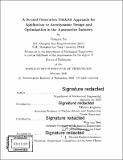A second generation URANS approach for application to aerodynamic design and optimization in the automotive industry
Author(s)
Xu, Liangyu,Ph.D.Massachusetts Institute of Technology.
Download1196373987-MIT.pdf (28.91Mb)
Alternative title
Second generation Unsteady Reynolds Averaged Navier Stokes approach for application to aerodynamic design and optimization in the automotive industry
Other Contributors
Massachusetts Institute of Technology. Department of Mechanical Engineering.
Advisor
Emilio Baglietto.
Terms of use
Metadata
Show full item recordAbstract
In the U.S., transportation is responsible for approximately 70% of all petroleum consumption and is now the largest source of carbon emissions and air pollution. Aerodynamics is an important aspect for energy saving and emission reduction in the automotive industry. In the design stage, aerodynamic drag is minimized through optimization of the vehicle shape, and Computational Fluid Dynamics (CFD) has become an invaluable tool to support this process. In combination with advanced optimization methods, CFD promises to considerably reduce the carbon footprint of modern passenger and good transportation. However, its success is severely limited by the poor description of complex unsteady turbulence at a practicable computational cost. For the flow past a car, unsteady turbulent flow structures are generated in the separation off the windshield, the mirrors, the wheels, and in the wake of the car body. Capturing these turbulent structures is important for an accurate evaluation of the aerodynamic drag, especially for trains and freight trucks, where flow interaction between multiple bodies is involved and influences the overall drag. While high fidelity CFD techniques like Direct Numerical Simulation (DNS) and Large Eddy Simulation (LES) offer the ability to resolve the necessary turbulent structures and therefore predicting the drag with high accuracy, their computational costs are high that cannot allow efficient optimization. Reynolds Averaged Navier-Stokes (RANS) approach is most widely used for its computationally effectiveness and robustness, but current RANS models have turned out to have a poor description of complex unsteady turbulence. Hybrid models offer a potential balance between accuracy and computational cost. Despite increased accuracy, the present hybrid models suffer from lack of robustness, grid consistency, ease of use. To address the issues of the existing hybrid models and to better address the industrial need for a robust, grid consistent, and widely applicable hybrid model, an interesting new approach has been proposed by Lenci [1] and Baglietto [2], which aims at increasing locally resolving the flow structures in the framework of second-generation URANS approach (2G-URANS), and is named STRUCT. The idea has shown the potential to provide improved accuracy, robustness, and mesh consistency for wall-bounded flows. However, the specific formulation delivered requires an averaging approach that introduces some application challenges, in particular being very sensitive to inlet boundary conditions and leading to spurious hybrid activation in open boundary external flows. This thesis assembles and demonstrates a new approach to support effective aerodynamic design and optimization through the delivery of an average-free STRUCT implementation applicable to all flow conditions. The new model introduces a source term in the [epsilon] equation of the standard k-[epsilon] model based on a time scale defined by the second invariant of the resolved velocity gradient tensor and therefore is named STRUCT-[epsilon] model. The new STRUCT-[epsilon] model is then validated on the fundamental cases and cases in the automotive industry, demonstrating improved accuracy in comparison with the most commonly used Realizable k-e model (RKE), at a comparable computational cost and with low mesh sensitivity. To further reduce the computational cost to support effective aerodynamic design, the extension of the STRUCT-[epsilon] model to fast running steady simulations is explored, and the results have shown improved performance with a better agreement with the reference data in comparison with the RKE model. On this basis, the STRUCT-[epsilon] model is applied to the optimization of a simplified tractor-trailer for demonstrating its value: at a computational cost amenable to industrial applications, it provides improved accuracy for the drag evaluation, and as a result, the optimal solution it generates through optimization is more accurate than the one obtained with the traditional RANS models.
Description
Thesis: Ph. D., Massachusetts Institute of Technology, Department of Mechanical Engineering, 2020 Cataloged from PDF of thesis. Includes bibliographical references (pages 201-212).
Date issued
2020Department
Massachusetts Institute of Technology. Department of Mechanical EngineeringPublisher
Massachusetts Institute of Technology
Keywords
Mechanical Engineering.